2006 CHEVROLET CORVETTE child seat
[x] Cancel search: child seatPage 54 of 426
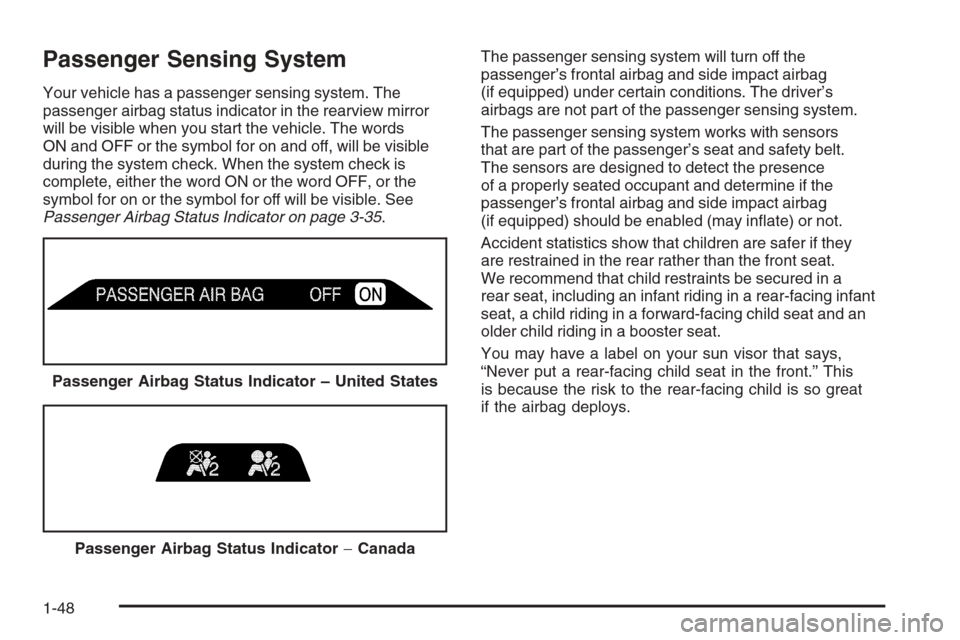
Passenger Sensing System
Your vehicle has a passenger sensing system. The
passenger airbag status indicator in the rearview mirror
will be visible when you start the vehicle. The words
ON and OFF or the symbol for on and off, will be visible
during the system check. When the system check is
complete, either the word ON or the word OFF, or the
symbol for on or the symbol for off will be visible. See
Passenger Airbag Status Indicator on page 3-35.The passenger sensing system will turn off the
passenger’s frontal airbag and side impact airbag
(if equipped) under certain conditions. The driver’s
airbags are not part of the passenger sensing system.
The passenger sensing system works with sensors
that are part of the passenger’s seat and safety belt.
The sensors are designed to detect the presence
of a properly seated occupant and determine if the
passenger’s frontal airbag and side impact airbag
(if equipped) should be enabled (may in�ate) or not.
Accident statistics show that children are safer if they
are restrained in the rear rather than the front seat.
We recommend that child restraints be secured in a
rear seat, including an infant riding in a rear-facing infant
seat, a child riding in a forward-facing child seat and an
older child riding in a booster seat.
You may have a label on your sun visor that says,
“Never put a rear-facing child seat in the front.” This
is because the risk to the rear-facing child is so great
if the airbag deploys. Passenger Airbag Status Indicator – United States
Passenger Airbag Status Indicator−Canada
1-48
Page 55 of 426
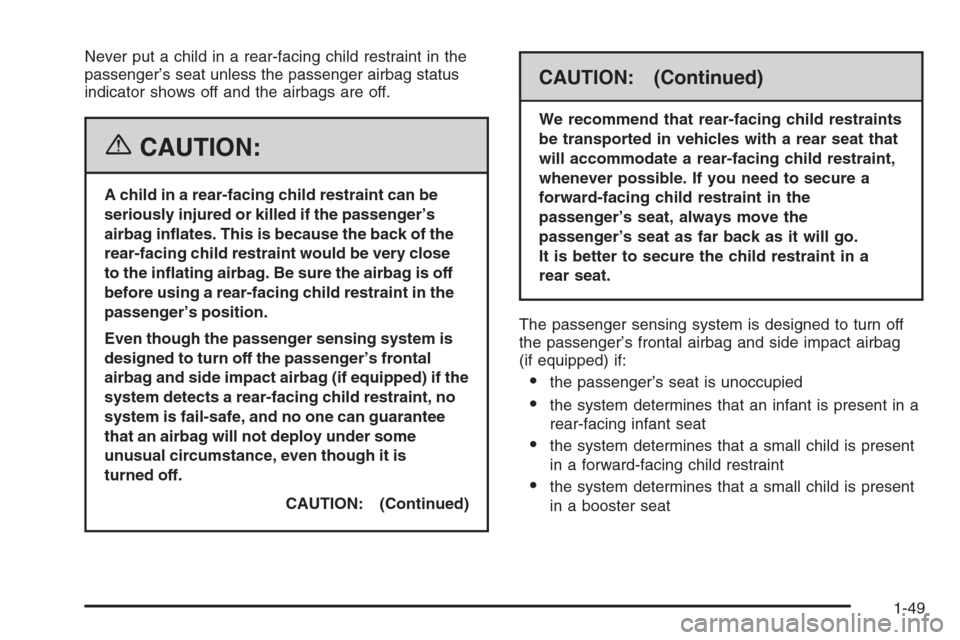
Never put a child in a rear-facing child restraint in the
passenger’s seat unless the passenger airbag status
indicator shows off and the airbags are off.
{CAUTION:
A child in a rear-facing child restraint can be
seriously injured or killed if the passenger’s
airbag in�ates. This is because the back of the
rear-facing child restraint would be very close
to the in�ating airbag. Be sure the airbag is off
before using a rear-facing child restraint in the
passenger’s position.
Even though the passenger sensing system is
designed to turn off the passenger’s frontal
airbag and side impact airbag (if equipped) if the
system detects a rear-facing child restraint, no
system is fail-safe, and no one can guarantee
that an airbag will not deploy under some
unusual circumstance, even though it is
turned off.
CAUTION: (Continued)
CAUTION: (Continued)
We recommend that rear-facing child restraints
be transported in vehicles with a rear seat that
will accommodate a rear-facing child restraint,
whenever possible. If you need to secure a
forward-facing child restraint in the
passenger’s seat, always move the
passenger’s seat as far back as it will go.
It is better to secure the child restraint in a
rear seat.
The passenger sensing system is designed to turn off
the passenger’s frontal airbag and side impact airbag
(if equipped) if:
the passenger’s seat is unoccupied
the system determines that an infant is present in a
rear-facing infant seat
the system determines that a small child is present
in a forward-facing child restraint
the system determines that a small child is present
in a booster seat
1-49
Page 56 of 426

a passenger takes his/her weight off of the seat for
a period of time
the passenger’s seat is occupied by a smaller
person, such as a child who has outgrown
child restraints
or if there is a critical problem with the airbag
system or the passenger sensing system
When the passenger’s frontal airbag and side impact
airbag (if equipped) have been turned off by the
passenger sensing system, the off indicator will light
and stay lit to remind you that the airbags are off.
If a child restraint has been installed and the on indicator
is lit, turn the vehicle off. Remove the child restraint
from the vehicle and reinstall the child restraint following
the child restraint manufacturer’s directions and refer
toSecuring a Child Restraint in the Passenger
Seat Position on page 1-35.
If after reinstalling the child restraint and restarting the
vehicle, the on indicator is still lit, check to make sure
that the vehicle’s seatback is not pressing the child
restraint into the seat cushion. If this happens, slightly
recline the vehicle’s seatback and adjust the seat
cushion if possible.
If the on indicator is still lit, do not secure the child
restraint in this vehicle and check with your dealer.The passenger sensing system is designed to enable
(may in�ate) the passenger’s frontal airbag and
side impact airbag (if equipped) anytime the system
senses that a person of adult size is sitting properly in
the passenger’s seat. When the passenger sensing
system has allowed the airbags to be enabled, the on
indicator will light and stay lit to remind you that the
airbags are active.
For some children who have outgrown child restraints
and for very small adults, the passenger sensing system
may or may not turn off the passenger’s frontal airbag
and side impact airbag (if equipped), depending upon
the person’s seating posture and body build. Everyone
in your vehicle who has outgrown child restraints should
wear a safety belt properly — whether or not there is an
airbag for that person.
If a person of adult-size is sitting in the passenger’s
seat, but the off indicator is lit, it could be because that
person is not sitting properly in the seat. If this happens,
turn the vehicle off and ask the person to place the
seatback in the fully upright position, then sit upright in
the seat, centered on the seat cushion, with the person’s
legs comfortably extended. Restart the vehicle and have
the person remain in this position for about two minutes.
This will allow the system to detect that person and then
enable the passenger’s frontal airbag and side impact
airbag (if equipped).
1-50
Page 172 of 426
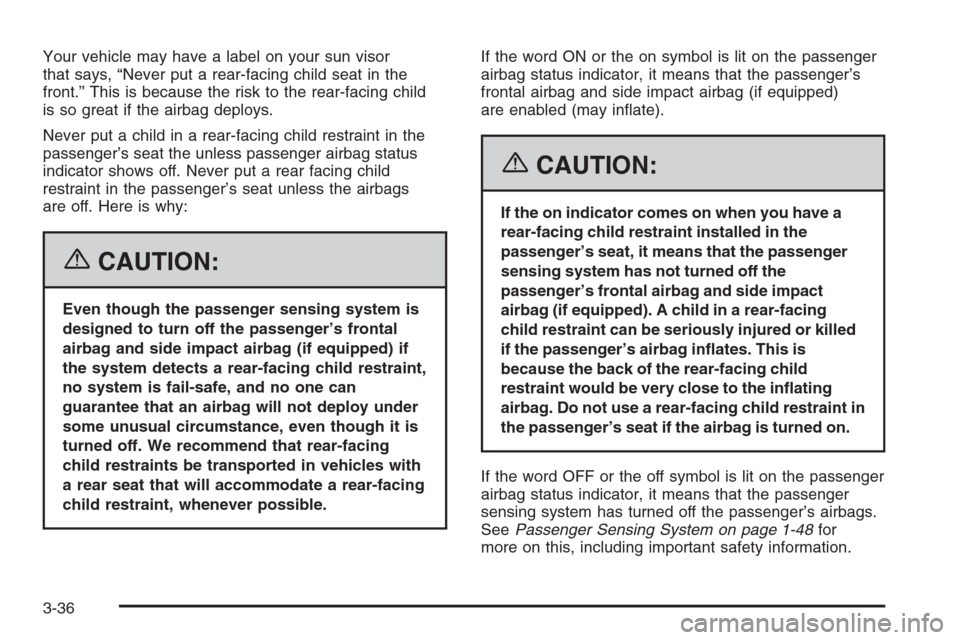
Your vehicle may have a label on your sun visor
that says, “Never put a rear-facing child seat in the
front.” This is because the risk to the rear-facing child
is so great if the airbag deploys.
Never put a child in a rear-facing child restraint in the
passenger’s seat the unless passenger airbag status
indicator shows off. Never put a rear facing child
restraint in the passenger’s seat unless the airbags
are off. Here is why:
{CAUTION:
Even though the passenger sensing system is
designed to turn off the passenger’s frontal
airbag and side impact airbag (if equipped) if
the system detects a rear-facing child restraint,
no system is fail-safe, and no one can
guarantee that an airbag will not deploy under
some unusual circumstance, even though it is
turned off. We recommend that rear-facing
child restraints be transported in vehicles with
a rear seat that will accommodate a rear-facing
child restraint, whenever possible.If the word ON or the on symbol is lit on the passenger
airbag status indicator, it means that the passenger’s
frontal airbag and side impact airbag (if equipped)
are enabled (may in�ate).
{CAUTION:
If the on indicator comes on when you have a
rear-facing child restraint installed in the
passenger’s seat, it means that the passenger
sensing system has not turned off the
passenger’s frontal airbag and side impact
airbag (if equipped). A child in a rear-facing
child restraint can be seriously injured or killed
if the passenger’s airbag in�ates. This is
because the back of the rear-facing child
restraint would be very close to the in�ating
airbag. Do not use a rear-facing child restraint in
the passenger’s seat if the airbag is turned on.
If the word OFF or the off symbol is lit on the passenger
airbag status indicator, it means that the passenger
sensing system has turned off the passenger’s airbags.
SeePassenger Sensing System on page 1-48for
more on this, including important safety information.
3-36
Page 276 of 426
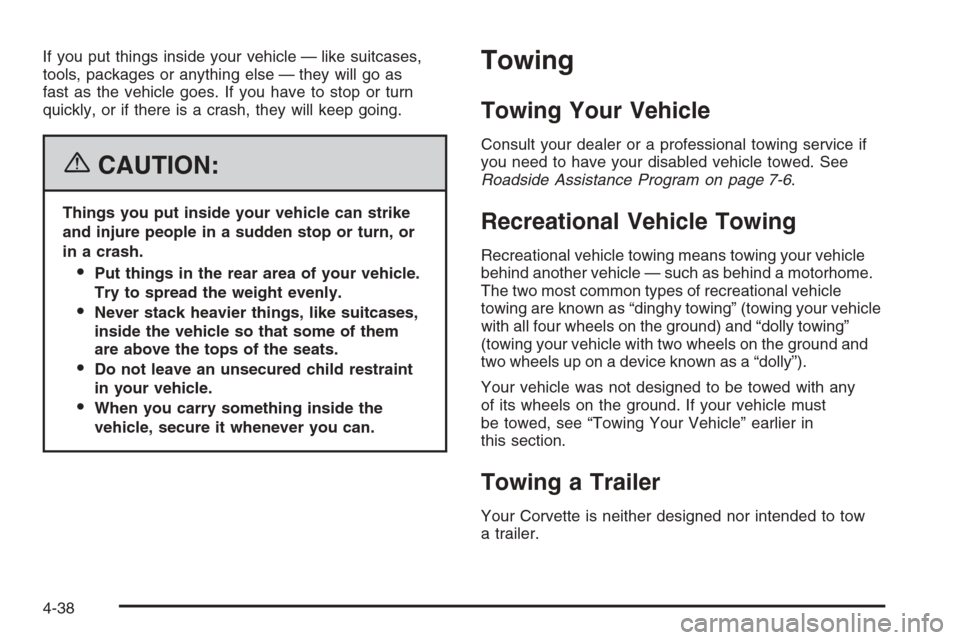
If you put things inside your vehicle — like suitcases,
tools, packages or anything else — they will go as
fast as the vehicle goes. If you have to stop or turn
quickly, or if there is a crash, they will keep going.
{CAUTION:
Things you put inside your vehicle can strike
and injure people in a sudden stop or turn, or
in a crash.
Put things in the rear area of your vehicle.
Try to spread the weight evenly.
Never stack heavier things, like suitcases,
inside the vehicle so that some of them
are above the tops of the seats.
Do not leave an unsecured child restraint
in your vehicle.
When you carry something inside the
vehicle, secure it whenever you can.
Towing
Towing Your Vehicle
Consult your dealer or a professional towing service if
you need to have your disabled vehicle towed. See
Roadside Assistance Program on page 7-6.
Recreational Vehicle Towing
Recreational vehicle towing means towing your vehicle
behind another vehicle — such as behind a motorhome.
The two most common types of recreational vehicle
towing are known as “dinghy towing” (towing your vehicle
with all four wheels on the ground) and “dolly towing”
(towing your vehicle with two wheels on the ground and
two wheels up on a device known as a “dolly”).
Your vehicle was not designed to be towed with any
of its wheels on the ground. If your vehicle must
be towed, see “Towing Your Vehicle” earlier in
this section.
Towing a Trailer
Your Corvette is neither designed nor intended to tow
a trailer.
4-38
Page 415 of 426

Check
Engine Light...............................................3-42
Checking Things Under the Hood......................5-10
Chemical Paint Spotting...................................5-90
Child Restraints
Child Restraint Systems...............................1-27
Infants and Young Children...........................1-25
Lower Anchors and Tethers for
Children..........................................1-31, 1-35
Older Children.............................................1-22
Securing a Child Restraint in the
Passenger Seat Position...........................1-35
Chime Level Adjustment.................................3-101
Cigarette Lighter.............................................3-25
Cleaning
Aluminum Wheels........................................5-89
Cargo Cover and Convenience Net................5-85
Coated Moldings.........................................5-84
Convertible Top...........................................5-88
Exterior Lamps/Lenses.................................5-86
Fabric/Carpet..............................................5-83
Fiberglass Springs.......................................5-90
Finish Care.................................................5-86
Inside of Your Vehicle..................................5-82
Instrument Panel, Vinyl, and Other
Plastic Surfaces.......................................5-85
Leather......................................................5-84
Removable Roof Panel.................................5-88
Tires..........................................................5-89Cleaning (cont.)
Underbody Maintenance...............................5-90
Washing Your Vehicle...................................5-86
Weatherstrips..............................................5-85
Windshield and Wiper Blades........................5-87
Climate Control System
Air Filter, Passenger Compartment.................3-31
Dual Automatic............................................3-25
Outlet Adjustment........................................3-30
Clutch, Hydraulic.............................................5-28
Collision Damage Repair..................................7-10
Compass...............................................2-38, 2-41
Competitive Driving, Racing or Other.................4-18
Control of a Vehicle.......................................... 4-6
Convenience Net............................................2-54
Convertible Top......................................2-60, 2-67
Coolant
Engine Temperature Gage............................3-41
Heater, Engine............................................2-24
Surge Tank Pressure Cap.............................5-32
Cooling System..............................................5-34
Courtesy Lamps.............................................3-19
Cruise Control................................................3-11
Cupholder(s)..................................................2-51
Customer Assistance Information
Courtesy Transportation.................................. 7-7
Customer Assistance for Text
Telephone (TTY) Users............................... 7-4
3
Page 419 of 426

Hood
Checking Things Under................................5-10
Release.....................................................5-11
Horn ............................................................... 3-6
How to Use This Manual...................................... ii
How to Wear Safety Belts Properly...................1-13
Hydraulic Clutch.............................................5-28
I
Ignition Positions.............................................2-22
Infants and Young Children, Restraints...............1-25
In�ation - Tire Pressure...................................5-64
Installing the Roof Panel..................................2-59
Instrument Panel
Overview..................................................... 3-4
Instrument Panel (I/P)
Brightness..................................................3-19
Cluster.......................................................3-33
J
Jump Starting.................................................5-46
K
Keyless Access System..................................... 2-4
Keyless Access System, Operation...................... 2-5
Keys............................................................... 2-3
L
Labeling, Tire Sidewall.....................................5-58
Lamps
Battery Run-Down Protection.........................3-20
Courtesy....................................................3-19
Exterior......................................................3-15
Exterior Lighting Battery Saver......................3-19
Fog ...........................................................3-17
Reading.....................................................3-20
Twilight Sentinel
®........................................3-18
LATCH System
Child Restraints...................................1-31, 1-35
Latches, Seatback............................................ 1-7
Lifting Your Vehicle, Tires.................................5-76
Light
Active Handling System................................3-40
Airbag Readiness........................................3-34
Anti-Lock Brake System Warning...................3-39
Brake System Warning.................................3-38
Fog Lamp ..................................................3-46
7
Page 423 of 426
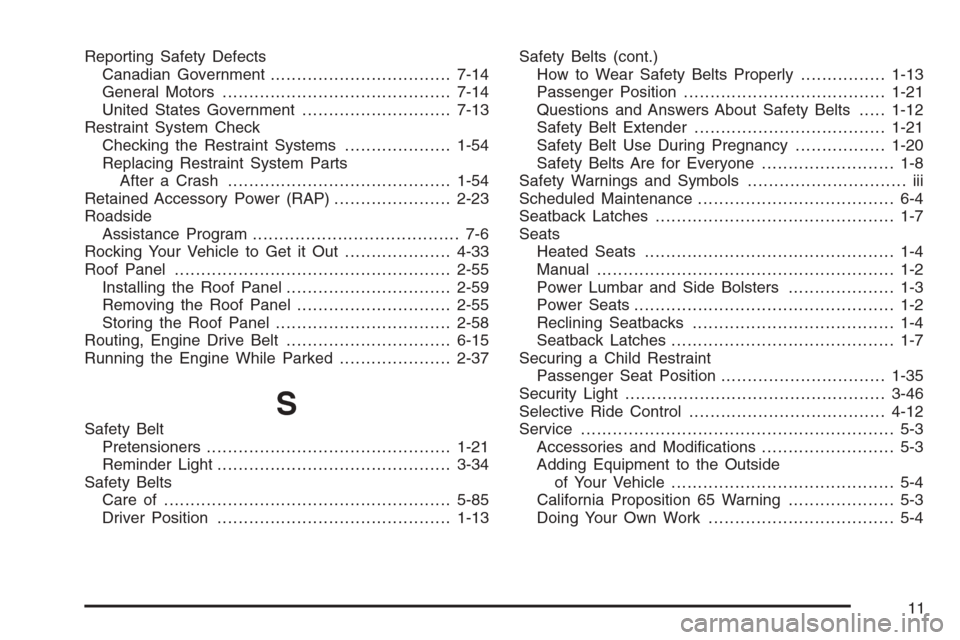
Reporting Safety Defects
Canadian Government..................................7-14
General Motors...........................................7-14
United States Government............................7-13
Restraint System Check
Checking the Restraint Systems....................1-54
Replacing Restraint System Parts
After a Crash..........................................1-54
Retained Accessory Power (RAP)......................2-23
Roadside
Assistance Program....................................... 7-6
Rocking Your Vehicle to Get it Out....................4-33
Roof Panel....................................................2-55
Installing the Roof Panel...............................2-59
Removing the Roof Panel.............................2-55
Storing the Roof Panel.................................2-58
Routing, Engine Drive Belt...............................6-15
Running the Engine While Parked.....................2-37
S
Safety Belt
Pretensioners..............................................1-21
Reminder Light............................................3-34
Safety Belts
Care of ......................................................5-85
Driver Position............................................1-13Safety Belts (cont.)
How to Wear Safety Belts Properly................1-13
Passenger Position......................................1-21
Questions and Answers About Safety Belts.....1-12
Safety Belt Extender....................................1-21
Safety Belt Use During Pregnancy.................1-20
Safety Belts Are for Everyone......................... 1-8
Safety Warnings and Symbols.............................. iii
Scheduled Maintenance..................................... 6-4
Seatback Latches............................................. 1-7
Seats
Heated Seats............................................... 1-4
Manual........................................................ 1-2
Power Lumbar and Side Bolsters.................... 1-3
Power Seats................................................. 1-2
Reclining Seatbacks...................................... 1-4
Seatback Latches.......................................... 1-7
Securing a Child Restraint
Passenger Seat Position...............................1-35
Security Light.................................................3-46
Selective Ride Control.....................................4-12
Service........................................................... 5-3
Accessories and Modi�cations......................... 5-3
Adding Equipment to the Outside
of Your Vehicle.......................................... 5-4
California Proposition 65 Warning.................... 5-3
Doing Your Own Work................................... 5-4
11